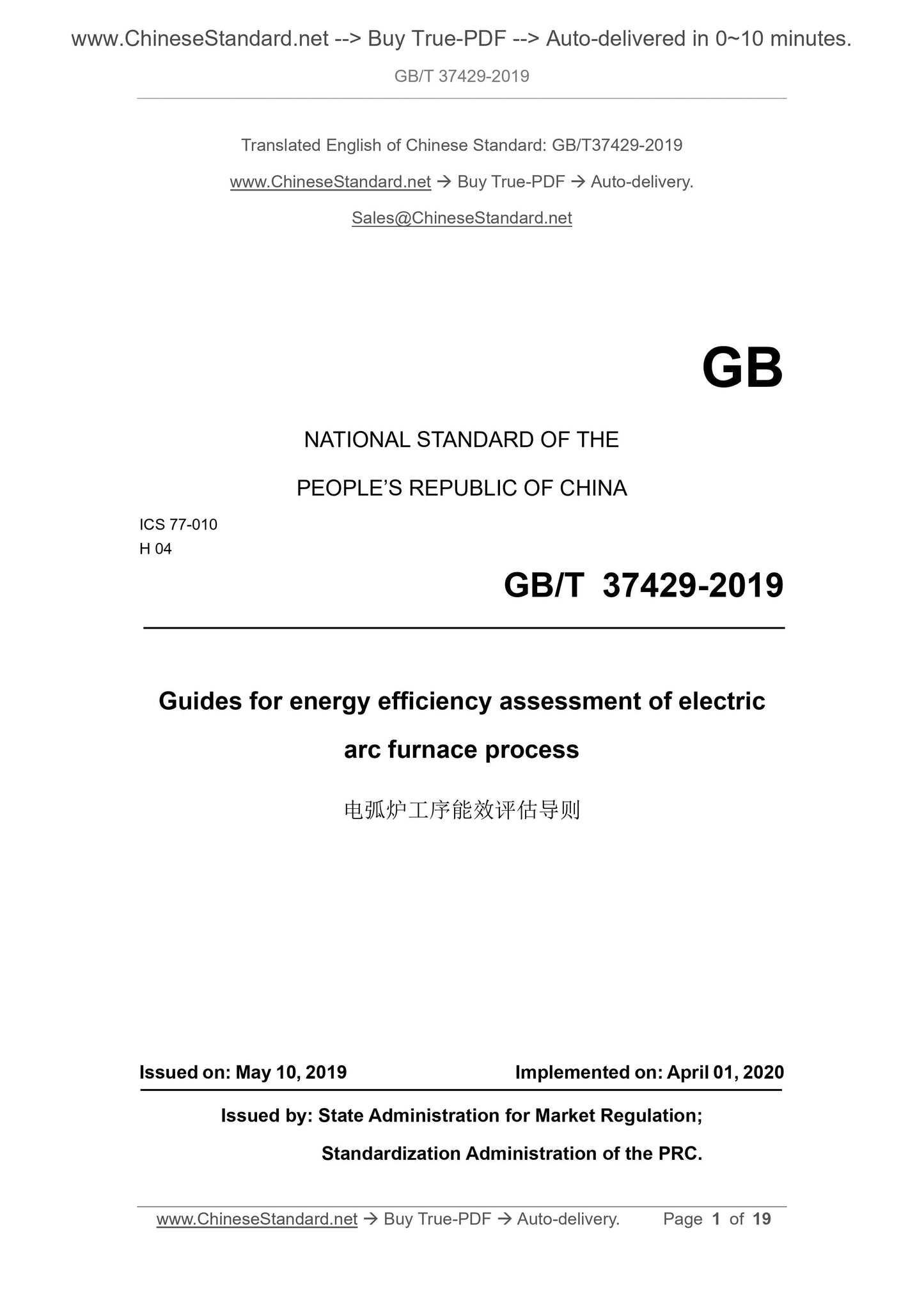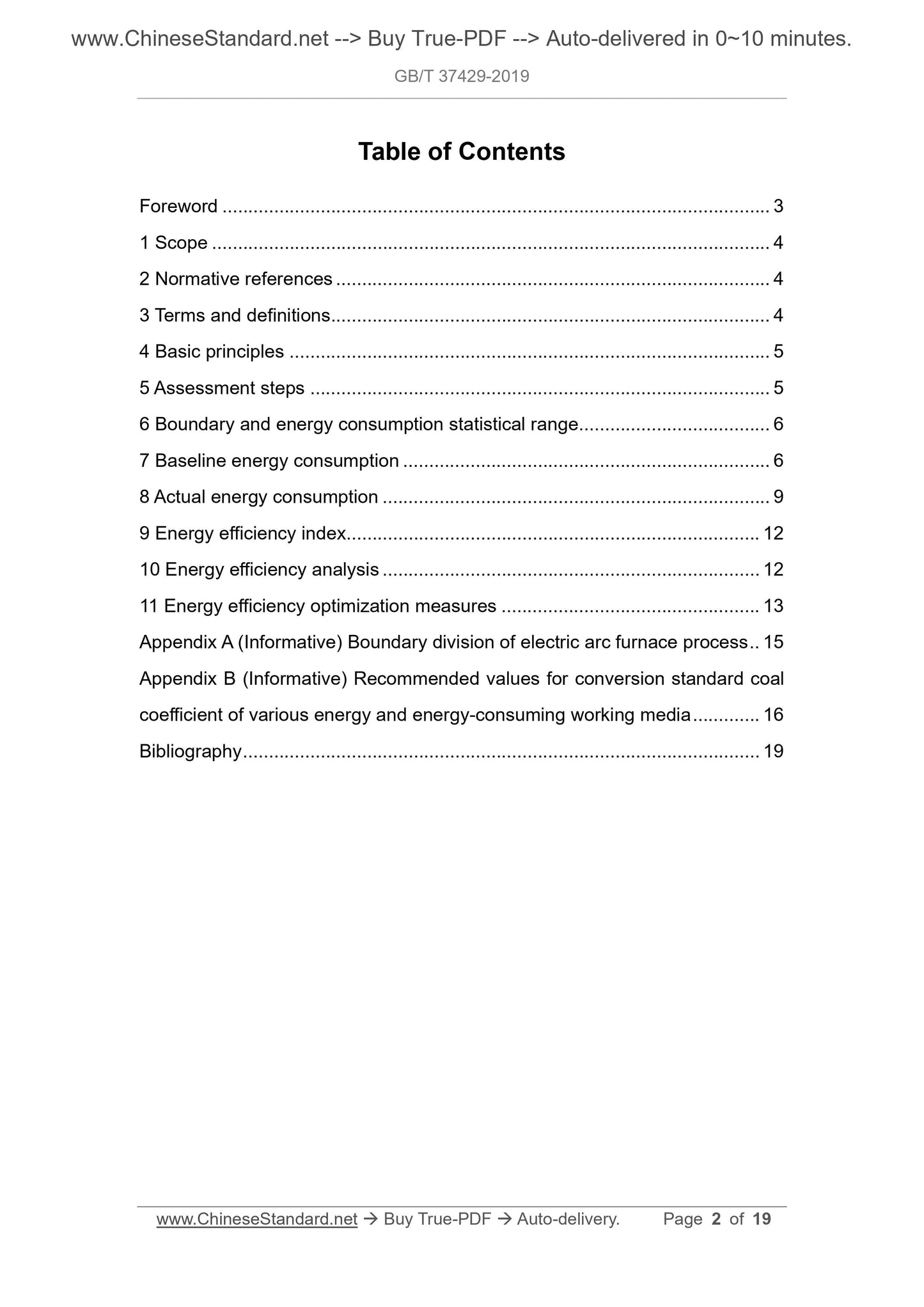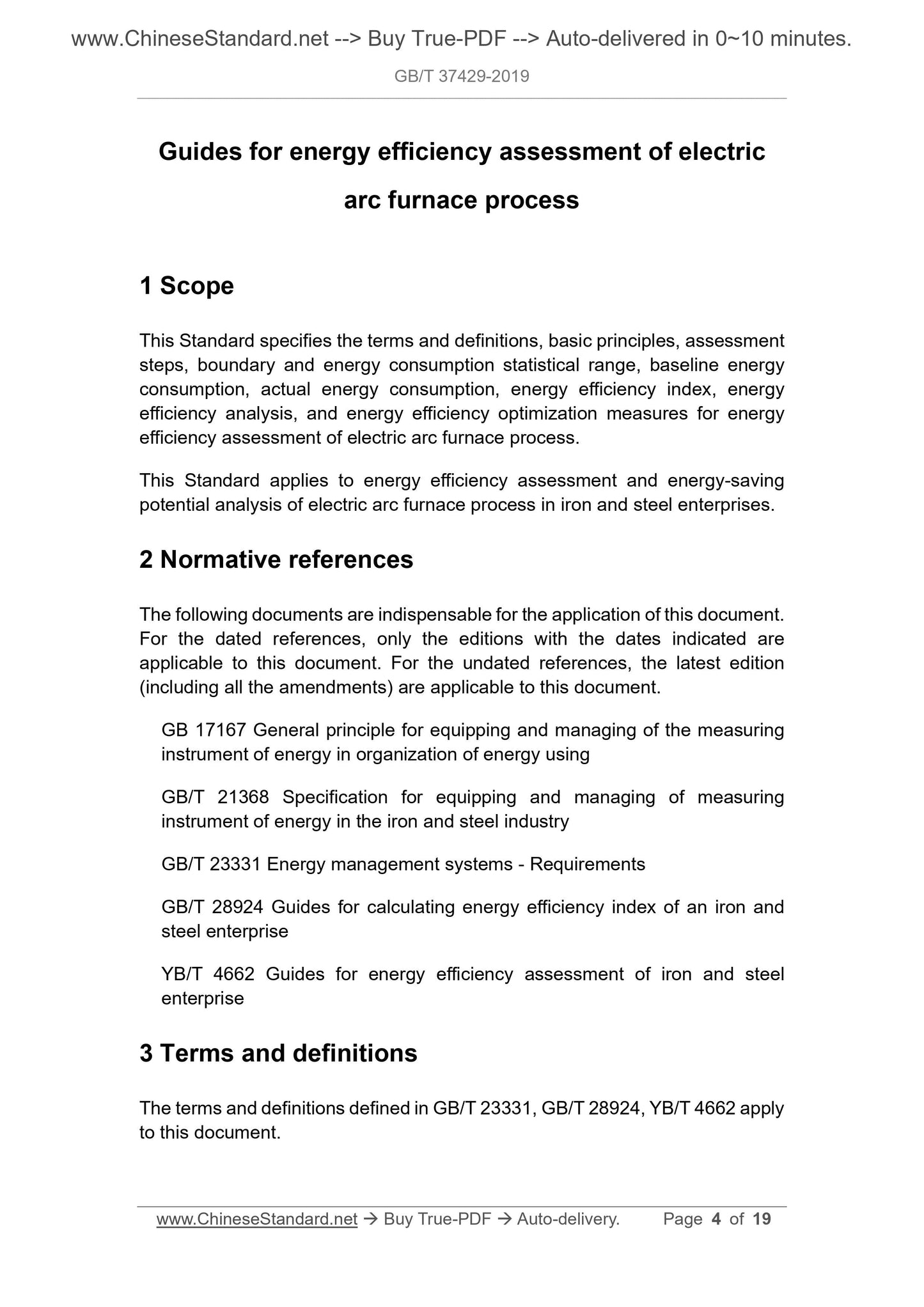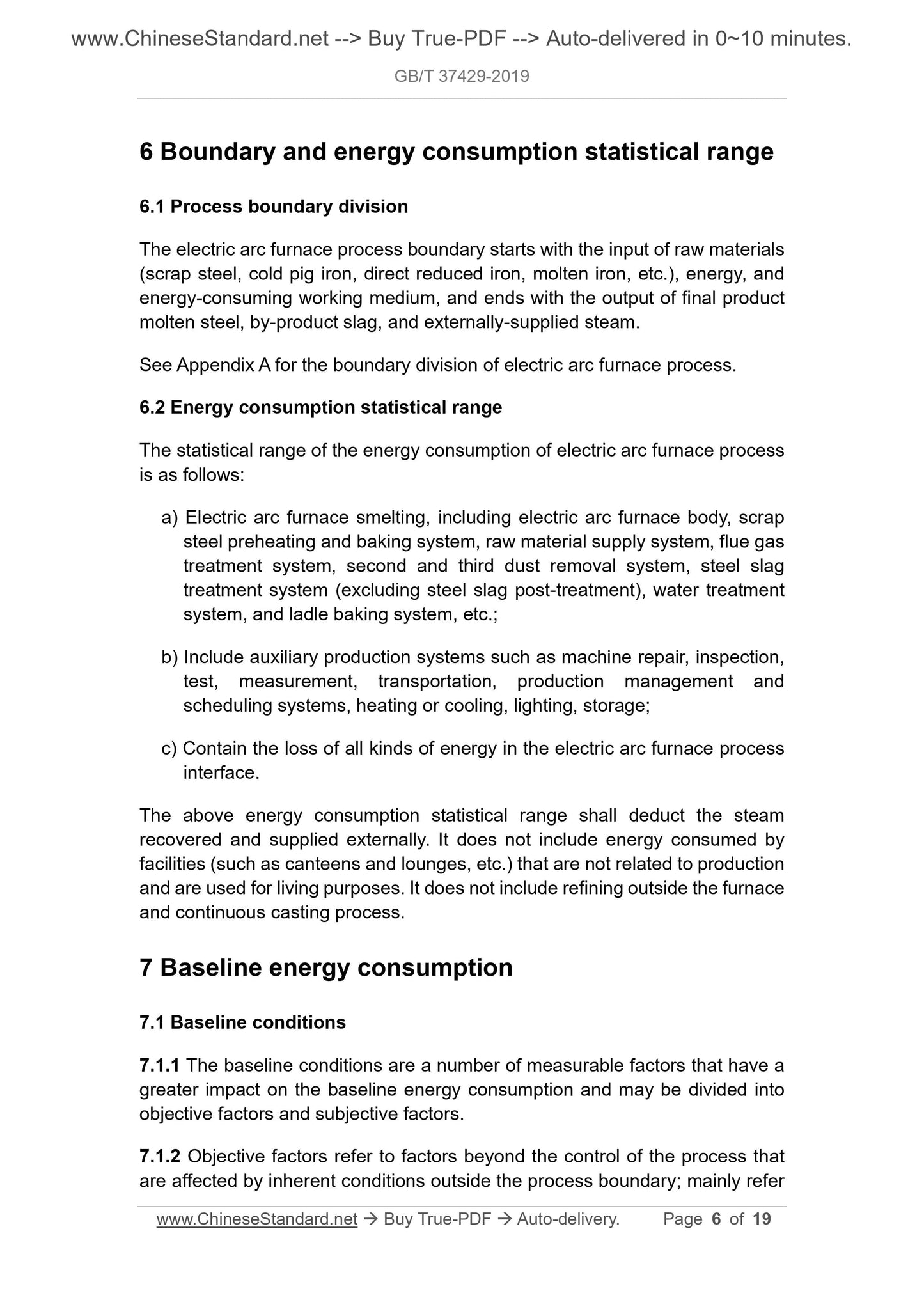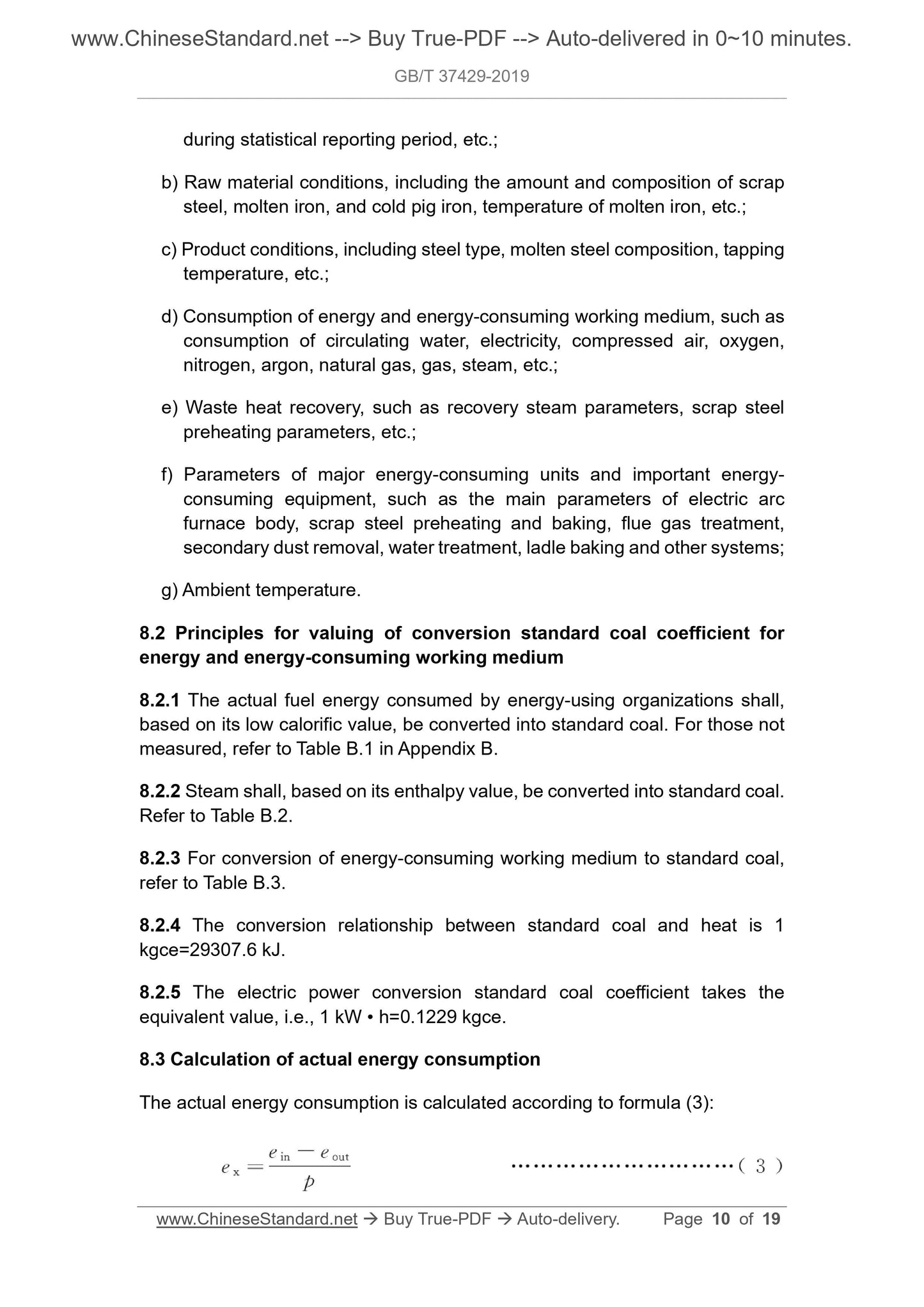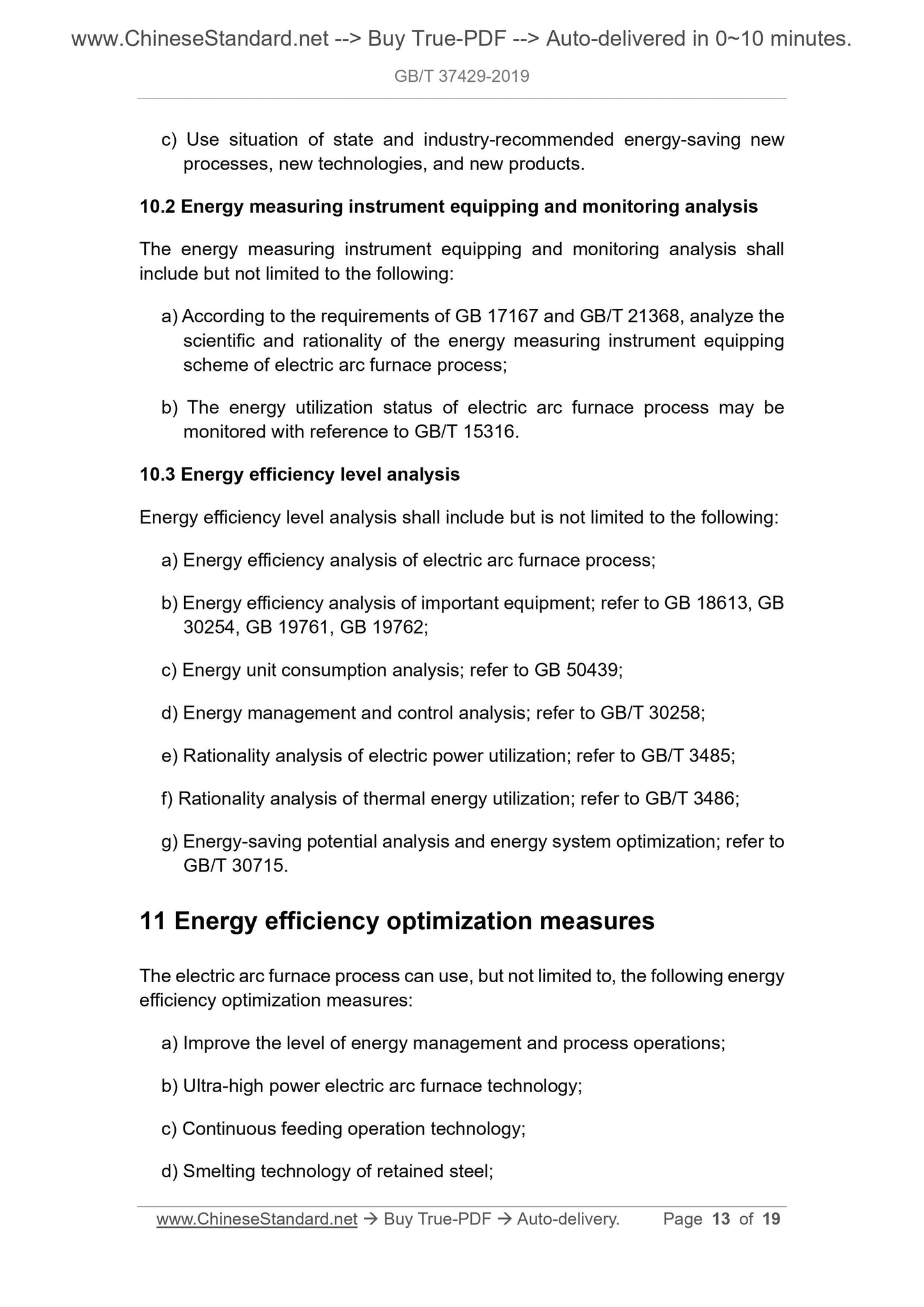1
/
of
6
PayPal, credit cards. Download editable-PDF and invoice in 1 second!
GB/T 37429-2019 English PDF (GBT37429-2019)
GB/T 37429-2019 English PDF (GBT37429-2019)
Regular price
$180.00 USD
Regular price
Sale price
$180.00 USD
Unit price
/
per
Shipping calculated at checkout.
Couldn't load pickup availability
Delivery: 3 seconds. Download true-PDF + Invoice.
Get QUOTATION in 1-minute: Click GB/T 37429-2019
Historical versions: GB/T 37429-2019
Preview True-PDF (Reload/Scroll if blank)
GB/T 37429-2019: Guides for energy efficiency assessment of electric arc furnace process
GB/T 37429-2019
NATIONAL STANDARD OF THE
PEOPLE’S REPUBLIC OF CHINA
ICS 77-010
H 04
Guides for energy efficiency assessment of electric
arc furnace process
ISSUED ON: MAY 10, 2019
IMPLEMENTED ON: APRIL 01, 2020
Issued by: State Administration for Market Regulation;
Standardization Administration of the PRC.
Table of Contents
Foreword ... 3
1 Scope ... 4
2 Normative references ... 4
3 Terms and definitions ... 4
4 Basic principles ... 5
5 Assessment steps ... 5
6 Boundary and energy consumption statistical range ... 6
7 Baseline energy consumption ... 6
8 Actual energy consumption ... 9
9 Energy efficiency index ... 12
10 Energy efficiency analysis ... 12
11 Energy efficiency optimization measures ... 13
Appendix A (Informative) Boundary division of electric arc furnace process .. 15
Appendix B (Informative) Recommended values for conversion standard coal
coefficient of various energy and energy-consuming working media ... 16
Bibliography ... 19
Guides for energy efficiency assessment of electric
arc furnace process
1 Scope
This Standard specifies the terms and definitions, basic principles, assessment
steps, boundary and energy consumption statistical range, baseline energy
consumption, actual energy consumption, energy efficiency index, energy
efficiency analysis, and energy efficiency optimization measures for energy
efficiency assessment of electric arc furnace process.
This Standard applies to energy efficiency assessment and energy-saving
potential analysis of electric arc furnace process in iron and steel enterprises.
2 Normative references
The following documents are indispensable for the application of this document.
For the dated references, only the editions with the dates indicated are
applicable to this document. For the undated references, the latest edition
(including all the amendments) are applicable to this document.
GB 17167 General principle for equipping and managing of the measuring
instrument of energy in organization of energy using
GB/T 21368 Specification for equipping and managing of measuring
instrument of energy in the iron and steel industry
GB/T 23331 Energy management systems - Requirements
GB/T 28924 Guides for calculating energy efficiency index of an iron and
steel enterprise
YB/T 4662 Guides for energy efficiency assessment of iron and steel
enterprise
3 Terms and definitions
The terms and definitions defined in GB/T 23331, GB/T 28924, YB/T 4662 apply
to this document.
6 Boundary and energy consumption statistical range
6.1 Process boundary division
The electric arc furnace process boundary starts with the input of raw materials
(scrap steel, cold pig iron, direct reduced iron, molten iron, etc.), energy, and
energy-consuming working medium, and ends with the output of final product
molten steel, by-product slag, and externally-supplied steam.
See Appendix A for the boundary division of electric arc furnace process.
6.2 Energy consumption statistical range
The statistical range of the energy consumption of electric arc furnace process
is as follows:
a) Electric arc furnace smelting, including electric arc furnace body, scrap
steel preheating and baking system, raw material supply system, flue gas
treatment system, second and third dust removal system, steel slag
treatment system (excluding steel slag post-treatment), water treatment
system, and ladle baking system, etc.;
b) Include auxiliary production systems such as machine repair, inspection,
test, measurement, transportation, production management and
scheduling systems, heating or cooling, lighting, storage;
c) Contain the loss of all kinds of energy in the electric arc furnace process
interface.
The above energy consumption statistical range shall deduct the steam
recovered and supplied externally. It does not include energy consumed by
facilities (such as canteens and lounges, etc.) that are not related to production
and are used for living purposes. It does not include refining outside the furnace
and continuous casting process.
7 Baseline energy consumption
7.1 Baseline conditions
7.1.1 The baseline conditions are a number of measurable factors that have a
greater impact on the baseline energy consumption and may be divided into
objective factors and subjective factors.
7.1.2 Objective factors refer to factors beyond the control of the process that
are affected by inherent conditions outside the process boundary; mainly refer
during statistical reporting period, etc.;
b) Raw material conditions, including the amount and composition of scrap
steel, molten iron, and cold pig iron, temperature of molten iron, etc.;
c) Product conditions, including steel type, molten steel composition, tapping
temperature, etc.;
d) Consumption of energy and energy-consuming working medium, such as
consumption of circulating water, electricity, compressed air, oxygen,
nitrogen, argon, natural gas, gas, steam, etc.;
e) Waste heat recovery, such as recovery steam parameters, scrap steel
preheating parameters, etc.;
f) Parameters of major energy-consuming units and important energy-
consuming equipment, such as the main parameters of electric arc
furnace body, scrap steel preheating and baking, flue gas treatment,
secondary dust removal, water treatment, ladle baking and other systems;
g) Ambient temperature.
8.2 Principles for valuing of conversion standard coal coefficient for
energy and energy-consuming working medium
8.2.1 The actual fuel energy consumed by energy-using organizations shall,
based on its low calorific value, be converted into standard coal. For those not
measured, refer to Table B.1 in Appendix B.
8.2.2 Steam shall, based on its enthalpy value, be converted into standard coal.
Refer to Table B.2.
8.2.3 For conversion of energy-consuming working medium to standard coal,
refer to Table B.3.
8.2.4 The conversion relationship between standard coal and heat is 1
kgce=29307.6 kJ.
8.2.5 The electric power conversion standard coal coefficient takes the
equivalent value, i.e., 1 kW • h=0.1229 kgce.
8.3 Calculation of actual energy consumption
The actual energy consumption is calculated according to formula (3):
c) Use situation of state and industry-recommended energy-saving new
processes, new technologies, and new products.
10.2 Energy measuring instrument equipping and monitoring analysis
The energy measuring instrument equipping and monitoring analysis shall
include but not limited to the following:
a) According to the requirements of GB 17167 and GB/T 21368, analyze the
scientific and rationality of the energy measuring instrument equipping
scheme of electric arc furnace process;
b) The energy utilization status of electric arc furnace process may be
monitored with reference to GB/T 15316.
10.3 Energy efficiency level analysis
Energy efficiency level analysis shall include but is not limited to the following:
a) Energy efficiency analysis of electric arc furnace process;
b) Energy efficiency analysis of important equipment; refer to GB 18613, GB
30254, GB 19761, GB 19762;
c) Energy unit consumption analysis; refer to GB 50439;
d) Energy management and control analysis; refer to GB/T 30258;
e) Rationality analysis of electric power utilization; refer to GB/T 3485;
f) Rationality analysis of thermal energy utilization; refer to GB/T 3486;
g) Energy-saving potential analysis and energy ...
Get QUOTATION in 1-minute: Click GB/T 37429-2019
Historical versions: GB/T 37429-2019
Preview True-PDF (Reload/Scroll if blank)
GB/T 37429-2019: Guides for energy efficiency assessment of electric arc furnace process
GB/T 37429-2019
NATIONAL STANDARD OF THE
PEOPLE’S REPUBLIC OF CHINA
ICS 77-010
H 04
Guides for energy efficiency assessment of electric
arc furnace process
ISSUED ON: MAY 10, 2019
IMPLEMENTED ON: APRIL 01, 2020
Issued by: State Administration for Market Regulation;
Standardization Administration of the PRC.
Table of Contents
Foreword ... 3
1 Scope ... 4
2 Normative references ... 4
3 Terms and definitions ... 4
4 Basic principles ... 5
5 Assessment steps ... 5
6 Boundary and energy consumption statistical range ... 6
7 Baseline energy consumption ... 6
8 Actual energy consumption ... 9
9 Energy efficiency index ... 12
10 Energy efficiency analysis ... 12
11 Energy efficiency optimization measures ... 13
Appendix A (Informative) Boundary division of electric arc furnace process .. 15
Appendix B (Informative) Recommended values for conversion standard coal
coefficient of various energy and energy-consuming working media ... 16
Bibliography ... 19
Guides for energy efficiency assessment of electric
arc furnace process
1 Scope
This Standard specifies the terms and definitions, basic principles, assessment
steps, boundary and energy consumption statistical range, baseline energy
consumption, actual energy consumption, energy efficiency index, energy
efficiency analysis, and energy efficiency optimization measures for energy
efficiency assessment of electric arc furnace process.
This Standard applies to energy efficiency assessment and energy-saving
potential analysis of electric arc furnace process in iron and steel enterprises.
2 Normative references
The following documents are indispensable for the application of this document.
For the dated references, only the editions with the dates indicated are
applicable to this document. For the undated references, the latest edition
(including all the amendments) are applicable to this document.
GB 17167 General principle for equipping and managing of the measuring
instrument of energy in organization of energy using
GB/T 21368 Specification for equipping and managing of measuring
instrument of energy in the iron and steel industry
GB/T 23331 Energy management systems - Requirements
GB/T 28924 Guides for calculating energy efficiency index of an iron and
steel enterprise
YB/T 4662 Guides for energy efficiency assessment of iron and steel
enterprise
3 Terms and definitions
The terms and definitions defined in GB/T 23331, GB/T 28924, YB/T 4662 apply
to this document.
6 Boundary and energy consumption statistical range
6.1 Process boundary division
The electric arc furnace process boundary starts with the input of raw materials
(scrap steel, cold pig iron, direct reduced iron, molten iron, etc.), energy, and
energy-consuming working medium, and ends with the output of final product
molten steel, by-product slag, and externally-supplied steam.
See Appendix A for the boundary division of electric arc furnace process.
6.2 Energy consumption statistical range
The statistical range of the energy consumption of electric arc furnace process
is as follows:
a) Electric arc furnace smelting, including electric arc furnace body, scrap
steel preheating and baking system, raw material supply system, flue gas
treatment system, second and third dust removal system, steel slag
treatment system (excluding steel slag post-treatment), water treatment
system, and ladle baking system, etc.;
b) Include auxiliary production systems such as machine repair, inspection,
test, measurement, transportation, production management and
scheduling systems, heating or cooling, lighting, storage;
c) Contain the loss of all kinds of energy in the electric arc furnace process
interface.
The above energy consumption statistical range shall deduct the steam
recovered and supplied externally. It does not include energy consumed by
facilities (such as canteens and lounges, etc.) that are not related to production
and are used for living purposes. It does not include refining outside the furnace
and continuous casting process.
7 Baseline energy consumption
7.1 Baseline conditions
7.1.1 The baseline conditions are a number of measurable factors that have a
greater impact on the baseline energy consumption and may be divided into
objective factors and subjective factors.
7.1.2 Objective factors refer to factors beyond the control of the process that
are affected by inherent conditions outside the process boundary; mainly refer
during statistical reporting period, etc.;
b) Raw material conditions, including the amount and composition of scrap
steel, molten iron, and cold pig iron, temperature of molten iron, etc.;
c) Product conditions, including steel type, molten steel composition, tapping
temperature, etc.;
d) Consumption of energy and energy-consuming working medium, such as
consumption of circulating water, electricity, compressed air, oxygen,
nitrogen, argon, natural gas, gas, steam, etc.;
e) Waste heat recovery, such as recovery steam parameters, scrap steel
preheating parameters, etc.;
f) Parameters of major energy-consuming units and important energy-
consuming equipment, such as the main parameters of electric arc
furnace body, scrap steel preheating and baking, flue gas treatment,
secondary dust removal, water treatment, ladle baking and other systems;
g) Ambient temperature.
8.2 Principles for valuing of conversion standard coal coefficient for
energy and energy-consuming working medium
8.2.1 The actual fuel energy consumed by energy-using organizations shall,
based on its low calorific value, be converted into standard coal. For those not
measured, refer to Table B.1 in Appendix B.
8.2.2 Steam shall, based on its enthalpy value, be converted into standard coal.
Refer to Table B.2.
8.2.3 For conversion of energy-consuming working medium to standard coal,
refer to Table B.3.
8.2.4 The conversion relationship between standard coal and heat is 1
kgce=29307.6 kJ.
8.2.5 The electric power conversion standard coal coefficient takes the
equivalent value, i.e., 1 kW • h=0.1229 kgce.
8.3 Calculation of actual energy consumption
The actual energy consumption is calculated according to formula (3):
c) Use situation of state and industry-recommended energy-saving new
processes, new technologies, and new products.
10.2 Energy measuring instrument equipping and monitoring analysis
The energy measuring instrument equipping and monitoring analysis shall
include but not limited to the following:
a) According to the requirements of GB 17167 and GB/T 21368, analyze the
scientific and rationality of the energy measuring instrument equipping
scheme of electric arc furnace process;
b) The energy utilization status of electric arc furnace process may be
monitored with reference to GB/T 15316.
10.3 Energy efficiency level analysis
Energy efficiency level analysis shall include but is not limited to the following:
a) Energy efficiency analysis of electric arc furnace process;
b) Energy efficiency analysis of important equipment; refer to GB 18613, GB
30254, GB 19761, GB 19762;
c) Energy unit consumption analysis; refer to GB 50439;
d) Energy management and control analysis; refer to GB/T 30258;
e) Rationality analysis of electric power utilization; refer to GB/T 3485;
f) Rationality analysis of thermal energy utilization; refer to GB/T 3486;
g) Energy-saving potential analysis and energy ...
Share
